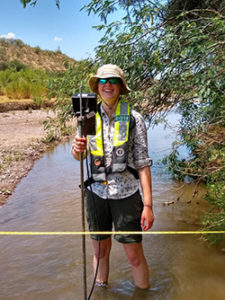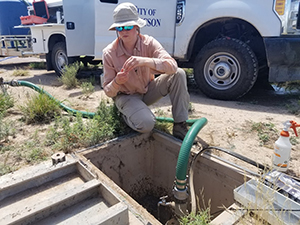Rachel Spinti, a student at the UA Department of Hydrology and Atmospheric Sciences, is the recipient of the 2019 Leonard Halpenny Intern Scholarship.
My Halpenny internship experience can be described by a quote from Chuck Faas at Tucson Water, “You cannot read everything in a book. You have to do it.” This statement resonated with me because being a good student does not equate to possessing skills necessary for a successful career. I am grateful for the Halpenny internship because it provided me with a mixture of valuable experiences. I also met and worked with a large handful of knowledgeable and experienced scientists who patiently answered all my questions and helped me complete tasks. I was fortunate to work with Tucson Water, the USGS, Montgomery and Associates (M&A), and NV5.
 I started my internship with Tucson Water. In a meeting with Dick Thompson and Maya Teyechea, we decided that a mix of field and office work would fulfill my interests. On my first day, I went out with Erin Gray and Tiffani Cañez, a former Halpenny intern, to set mosquito traps near the recharge basins in Avra Valley for the mosquito monitoring program. We measured water levels and Erin taught me the techniques she uses to sound wells. I participated in multiple well-sampling and well-sounding rounds with the team, which consisted of Erin, Tiffani, Max Campos, Scott Gallo, and Bri Rupkalvis; they were friendly and seemed to really enjoy their work. One of the best experiences I had was when Chuck Faas, a hydrologist and the Tucson Water expert on well development, gave me a private tour of a production-well drill site. I thought it was impressive that the drillers knew what material they were drilling through based on the vibration and movement of the drill. It was also really neat to see the soil samples drying in the sun. Once the drilling was complete, I joined Chuck for a day of pump development. I had no idea what pump development was, but over the course of the day I watched Chuck instruct the consultant to turn the pump on, off, up, and down. The point of pump development is to pump and surge the well to clean out the casing and filter-pack. Then, water flows more smoothly from the aquifer into the well. Another goal of this process is to determine how many gallons per minute the well could produce, which is called specific capacity.
I started my internship with Tucson Water. In a meeting with Dick Thompson and Maya Teyechea, we decided that a mix of field and office work would fulfill my interests. On my first day, I went out with Erin Gray and Tiffani Cañez, a former Halpenny intern, to set mosquito traps near the recharge basins in Avra Valley for the mosquito monitoring program. We measured water levels and Erin taught me the techniques she uses to sound wells. I participated in multiple well-sampling and well-sounding rounds with the team, which consisted of Erin, Tiffani, Max Campos, Scott Gallo, and Bri Rupkalvis; they were friendly and seemed to really enjoy their work. One of the best experiences I had was when Chuck Faas, a hydrologist and the Tucson Water expert on well development, gave me a private tour of a production-well drill site. I thought it was impressive that the drillers knew what material they were drilling through based on the vibration and movement of the drill. It was also really neat to see the soil samples drying in the sun. Once the drilling was complete, I joined Chuck for a day of pump development. I had no idea what pump development was, but over the course of the day I watched Chuck instruct the consultant to turn the pump on, off, up, and down. The point of pump development is to pump and surge the well to clean out the casing and filter-pack. Then, water flows more smoothly from the aquifer into the well. Another goal of this process is to determine how many gallons per minute the well could produce, which is called specific capacity.
At the office, I performed a variety of tasks. First, I used ArcMap to identify affected wells within or near contaminated sites. Second, I participated in a meeting between Tucson Water and the USGS about how microgravity monitoring could be used to observe managed recharge projects. Third, I helped Hector Zamora create well logs in Strater. This was an interesting task because I was looking at the history and use of production wells. Some well files contained a lot of information from the original drilling of the well, but others were missing information. This confirmed the importance of taking good field notes for me. Fourth, I sat in on a meeting concerning a proposed remediation plan for a contaminated site in Tucson. I found this meeting very informative because I listened to employees discuss the consequences of the current plan, which needed a lot of revising. During my time at the office, I also went on a tour of the Santa Cruz Heritage project with Margaret Snyder and Dick.
Next, I met up with the USGS, where I had the opportunity to work on multiple aspects of hydrology. I learned about some aspects by chatting with different USGS employees, who were kind enough to set aside time to meet with me. But I also had a more hands-on experience. The first day, I went into the field with Justine Mayo to record water levels and compaction measurements in the Tucson aquifer. Aquifer compaction was measured using extensometers, which were new to me, but I could see the value of the data they provided. The next morning, I helped Libby Kahler check that the gravimeter was working properly, which is a fairly delicate and finicky instrument. The USGS uses precise gravimeter data to quantify storage changes of the Tucson aquifer. We moved the gravimeter between different rooms in the basement and I leveled the instrument so that we could get a reading. The following day, I joined Edyth Hermosillo in the water-quality truck. We went to West Clear Creek, near Camp Verde, Arizona to take a surface-water sample and to check the stream gage there. This was a neat experience because we did some of the water quality tests in the mobile lab at the back of the truck. Another day, I went stream gaging with Kurt Ehrenberg at Aravaipa Creek, near Mammoth, Arizona. He taught me how to check stream gages and allowed me to use the flow tracker to measure the discharge in the creek. Back at the office, Kurt showed me how he uploads the data and how he applies corrections to the data, if necessary. Later in the summer, I spent another day stream gaging with Lisa Ashmore because I enjoyed standing in running water. I spent my final day at the USGS with Libby. We drove to various sites in Tucson with the gravimeter to measure the differences in gravity between locations. However, while transporting the gravimeter a “tear” occurred, meaning the gravimeter had been bumped and that we could no longer take gravity readings. That was too bad, but I was grateful to gain experience using such a precise instrument. Since my work finished early, I spent some time with Jay Cederberg. He explained to me his work on large-scale particle image velocimetry (LSPIV), a new technology that uses image-processing software to quantify the velocity flow field on the surface of a stream, so discharge can be estimated. This technology was intriguing because Jay uploads a video of turbulent flow from a stream surface to the software package and can estimate discharge fairly accurately. Later on, I joined Jay on a trip to the Patagonia Mountains to check up on the video camera and stream gage at a site where he has been testing the LSPIV technique.
My next stop was M&A where I joined John Petti on a well monitoring round in eastern central Arizona. I prepared for this trip by reading the report that M&A had provided to their client about the previous year’s monitoring round. Our assignment was to measure water levels in production and monitoring wells and to sample the production wells. This was the first time I got experience taking water levels in production wells, which was tricky. On our first full day in the field, the monsoons dumped rain on us. Consequently, we were behind schedule, so the following day we had to work extra hard in some threatening weather conditions. I certainly improved my notetaking, sounder-lowering, and gate-opening skills as a result of the delay. During our trip, we also visited some surface water sites, including a sinkhole. It was really cool! After our monitoring round, I spent a few days in the office uploading and double-checking the data. This was a valuable experience because I was able to see the historical trends in the data and how the project has changed over time.
Finally, I joined the NV5 Tucson office. I had previous experience with green infrastructure (GI) projects, and Mark Murphy was interested in creating a proposal for a GI project. Mark had obtained GIS data from Pima County Regional Flood Control District (PCRFCD) and the Watershed Management Group (WMG). I used this data to identify areas in the Airport Wash where frequent flooding has affected high risk populations. We wanted to find specific locations where green infrastructure could be implemented to alleviate flooding. This experience was different than the others because there was not a field component. However, it helped to give me a better idea of how to put together a project proposal using available data. This task also improved my GIS analysis skills.
I would like to thank AHS for supporting this internship and providing worthwhile opportunities for students. I would also like to thank those who planned beneficial experiences for me including Marla Odom, Dick Thompson, Maya Teyechea, Jay Cederberg, and Mark Murphy. In addition, I am grateful for Evan Canfield and Martha Whitaker for writing exceptional letters of recommendation.
